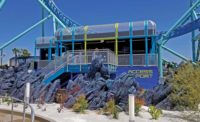Founded in 1942, ZGF Architects LLP consistently delivers large, innovative projects in the health care, higher education and government sectors in California. The firm’s designs embrace the state’s commitment to sustainability and often accommodate multiple purposes within a single structure.
“We do not have a specific architectural style. Instead, our work is anchored by our approach to each and every project,” says Ted Hyman, ZGF managing partner.
One example is the Warren J. Baker Center for Science and Mathematics at Cal Poly San Luis Obispo, completed in 2013. ZGF designed 208,608 sq ft of flexible space for three academic departments and three research institutes. The LEED Gold building includes hydronic chilled beam heating and cooling in laboratories—the first time chilled beams were used in a teaching laboratory in California. The ZGF team also had to work around 114 laboratory fume hoods.
“(ZGF) listened and asked questions to be sure they understood our vision, values and goals,” says Phil Bailey, director of Frost Endowment at Cal Poly SLO. “They came back with innovative ideas and brought in the consultants needed to build the best building.”
Bailey says the school’s original goal was to achieve LEED Silver for the center but ZGF knew they could do better. “Despite the number of (high-energy-consuming) fume hoods that they had to work around, and the fact that the state did not fund solar panels for the roof, ZGF was still able to design a certified LEED Gold building,” he says.
The 600-person firm employs 103 in Los Angeles, with other offices in Portland, Ore., Seattle, Washington, D.C., New York and Vancouver. ZGF currently has more than 40 projects in California under design or construction, and California projects generate more than a third of the firm’s total revenue. Combined, these projects total well over 5 million sq ft and are worth upward of $1.5 billion.
ZGF’s recently completed projects include the Altman Clinical and Translational Research Institute in San Diego, a building designed to accommodate four diverse groups on an environmentally sensitive site with a 50-ft grade change. Another ZGF project, the Santa Clara Family Justice Center in San Jose, required three separate circulation patterns and designated areas.
“Our workload remains very strong, due in part to the diversity of our client base,” Hyman says. “With California’s leadership in sustainability, our experience designing high-performance and net-zero energy buildings has put us in a great position to bring value to clients facing the increasingly stringent code changes in the state.”
ZGF’s most significant current projects in the Golden State include the $368-million California Air Resources Board (CARB) headquarters in Riverside; the $274-million 1215 O St. building in Sacramento; and Stanford University’s Redwood City campus.
The CARB project, which is still in design and expected to break ground this fall, will house the agency’s 400-plus employees. The building will be one of the world’s largest and most advanced emissions testing and research facilities, and the largest true net-zero energy facility of its kind, says Braulio Baptista, ZGF partner.
Another environmentally friendly ZGF project is 1215 O St., designed for the California Dept. of General Services. Scheduled to break ground this summer, the structure is net-zero energy as designed and targeting LEED Platinum. It will use 60% less water than office buildings of a similar size, and solar panels on the roof will be supplemented by offsite solar energy through the Sacramento utility district, says Allyn Stellmacher, ZGF partner.
ZGF employed its experience in urban planning to design Stanford University’s first satellite campus in Redwood City. The project sits on 34 acres and features 13 buildings across 3,200,000 sq ft. Phase 1 is slated to open in early 2019. Campus designs hark back to the university’s main campus in Palo Alto, with French limestone and terra-cotta building cladding.
Another of ZGF’s current projects is the $51-million LA BioMed facility on the Harbor-UCLA Medical Center Campus in Torrance, Calif. Under construction with a February 2019 completion date, the 77,800-sq-ft research building will house offices as well as a data center, freezer farm and laboratories.
Abel Gonzalez, Southern California business unit leader for DPR Construction, the general contractor on LA BioMed, describes ZGF’s leadership and project teams as collaborative, trusting partners. Gonzalez also worked with the firm on the Children’s Hospital Los Angeles’ new pediatrics tower in the mid-2000s.
ZGF always demonstrates “tremendous integrity and character while working with us and others to find the right solution for the project,” Gonzales says.









Post a comment to this article
Report Abusive Comment